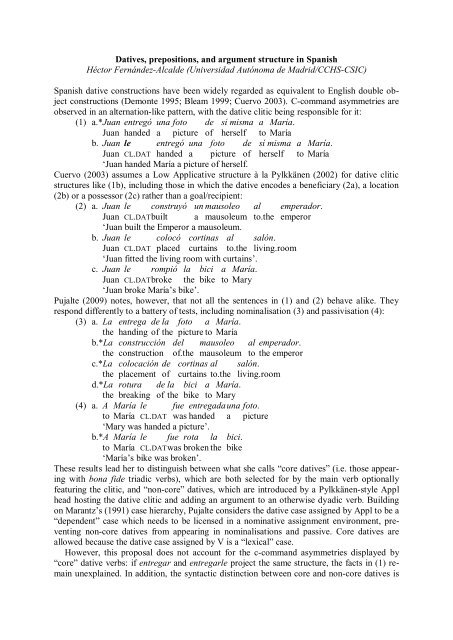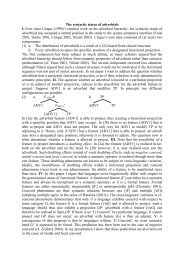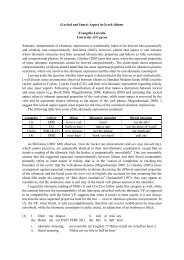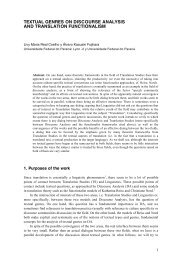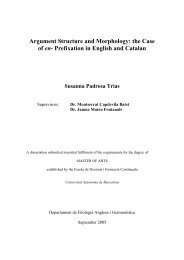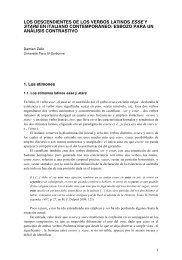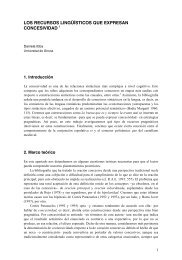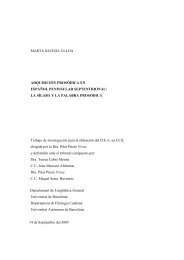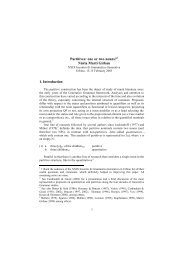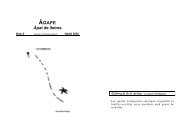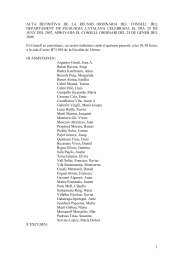Datives, prepositions, and argument structure in Spanish Héctor ...
Datives, prepositions, and argument structure in Spanish Héctor ...
Datives, prepositions, and argument structure in Spanish Héctor ...
Create successful ePaper yourself
Turn your PDF publications into a flip-book with our unique Google optimized e-Paper software.
<strong>Datives</strong>, <strong>prepositions</strong>, <strong>and</strong> <strong>argument</strong> <strong>structure</strong> <strong>in</strong> <strong>Spanish</strong><br />
<strong>Héctor</strong> Fernández-Alcalde (Universidad Autónoma de Madrid/CCHS-CSIC)<br />
<strong>Spanish</strong> dative constructions have been widely regarded as equivalent to English double object<br />
constructions (Demonte 1995; Bleam 1999; Cuervo 2003). C-comm<strong>and</strong> asymmetries are<br />
observed <strong>in</strong> an alternation-like pattern, with the dative clitic be<strong>in</strong>g responsible for it:<br />
(1) a.*Juan entregó una foto de sí misma a María.<br />
Juan h<strong>and</strong>ed a picture of herself to María<br />
b. Juan le entregó una foto de sí misma a María.<br />
Juan CL.DAT h<strong>and</strong>ed a picture of herself to María<br />
„Juan h<strong>and</strong>ed María a picture of herself.<br />
Cuervo (2003) assumes a Low Applicative <strong>structure</strong> à la Pylkkänen (2002) for dative clitic<br />
<strong>structure</strong>s like (1b), <strong>in</strong>clud<strong>in</strong>g those <strong>in</strong> which the dative encodes a beneficiary (2a), a location<br />
(2b) or a possessor (2c) rather than a goal/recipient:<br />
(2) a. Juan le construyó un mausoleo al emperador.<br />
Juan CL.DAT built a mausoleum to.the emperor<br />
„Juan built the Emperor a mausoleum.<br />
b. Juan le colocó cort<strong>in</strong>as al salón.<br />
Juan CL.DAT placed curta<strong>in</strong>s to.the liv<strong>in</strong>g.room<br />
„Juan fitted the liv<strong>in</strong>g room with curta<strong>in</strong>s‟.<br />
c. Juan le rompió la bici a María.<br />
Juan CL.DAT broke the bike to Mary<br />
„Juan broke María‟s bike‟.<br />
Pujalte (2009) notes, however, that not all the sentences <strong>in</strong> (1) <strong>and</strong> (2) behave alike. They<br />
respond differently to a battery of tests, <strong>in</strong>clud<strong>in</strong>g nom<strong>in</strong>alisation (3) <strong>and</strong> passivisation (4):<br />
(3) a. La entrega de la foto a María.<br />
the h<strong>and</strong><strong>in</strong>g of the picture to María<br />
b.*La construcción del mausoleo al emperador.<br />
the construction of.the mausoleum to the emperor<br />
c.*La colocación de cort<strong>in</strong>as al salón.<br />
the placement of curta<strong>in</strong>s to.the liv<strong>in</strong>g.room<br />
d.*La rotura de la bici a María.<br />
the break<strong>in</strong>g of the bike to Mary<br />
(4) a. A María le fue entregada una foto.<br />
to María CL.DAT was h<strong>and</strong>ed a picture<br />
„Mary was h<strong>and</strong>ed a picture‟.<br />
b.*A María le fue rota la bici.<br />
to María CL.DAT was broken the bike<br />
„María‟s bike was broken‟.<br />
These results lead her to dist<strong>in</strong>guish between what she calls “core datives” (i.e. those appear<strong>in</strong>g<br />
with bona fide triadic verbs), which are both selected for by the ma<strong>in</strong> verb optionally<br />
featur<strong>in</strong>g the clitic, <strong>and</strong> “non-core” datives, which are <strong>in</strong>troduced by a Pylkkänen-style Appl<br />
head host<strong>in</strong>g the dative clitic <strong>and</strong> add<strong>in</strong>g an <strong>argument</strong> to an otherwise dyadic verb. Build<strong>in</strong>g<br />
on Marantz‟s (1991) case hierarchy, Pujalte considers the dative case assigned by Appl to be a<br />
“dependent” case which needs to be licensed <strong>in</strong> a nom<strong>in</strong>ative assignment environment, prevent<strong>in</strong>g<br />
non-core datives from appear<strong>in</strong>g <strong>in</strong> nom<strong>in</strong>alisations <strong>and</strong> passive. Core datives are<br />
allowed because the dative case assigned by V is a “lexical” case.<br />
However, this proposal does not account for the c-comm<strong>and</strong> asymmetries displayed by<br />
“core” dative verbs: if entregar <strong>and</strong> entregarle project the same <strong>structure</strong>, the facts <strong>in</strong> (1) rema<strong>in</strong><br />
unexpla<strong>in</strong>ed. In addition, the syntactic dist<strong>in</strong>ction between core <strong>and</strong> non-core datives is
not as clear-cut as Pujalte‟s analysis predicts, s<strong>in</strong>ce beneficiary <strong>and</strong> some locative dative verbs<br />
do allow passivisation:<br />
(5) a. Al emperador le fue construido un mausoleo.<br />
to.the emperor CL.DAT was built a mausoleum<br />
„The Emperor was built a mausoleum‟.<br />
b. Al animal le fue colocado un collar satelital.<br />
to.the animal CL.DAT was placed a collar satellite<br />
„The animal was fitted with a satellite collar‟.<br />
From the semantic po<strong>in</strong>t of view, only goal, beneficiary, <strong>and</strong> locative imply a transfer of possession<br />
of any k<strong>in</strong>d: h<strong>and</strong><strong>in</strong>g a picture, build<strong>in</strong>g a mausoleum or <strong>in</strong>stall<strong>in</strong>g <strong>and</strong> antivirus result<br />
<strong>in</strong> Mary hav<strong>in</strong>g the picture, the Emperor hav<strong>in</strong>g a mausoleum, <strong>and</strong> the animal hav<strong>in</strong>g a<br />
satellite collar. Conversely, break<strong>in</strong>g a bike does not result <strong>in</strong> Mary (not) hav<strong>in</strong>g a bike; it encodes<br />
a change of state undergone by the bike, its possession rema<strong>in</strong><strong>in</strong>g unaffected.<br />
The <strong>in</strong>teraction between the tests of nom<strong>in</strong>alisation <strong>and</strong> passive <strong>and</strong> the semantic <strong>in</strong>terpretation<br />
of the <strong>structure</strong> gives a tripartite dist<strong>in</strong>ction of <strong>Spanish</strong> datives:<br />
(6) Test entregar construir/colocar romper<br />
Nom<strong>in</strong>alisation <br />
Passive /? <br />
Change of possession <br />
This dist<strong>in</strong>ction can be accounted for if a f<strong>in</strong>er-gra<strong>in</strong>ed <strong>argument</strong> <strong>structure</strong> is proposed:<br />
1. Verbs of the entregar-type display an alternation ak<strong>in</strong> to English dative alternation. The<br />
non-doubl<strong>in</strong>g variant, equivalent to the to-variant <strong>in</strong> English, encodes a locative resultative<br />
construction headed by the preposition a: this variant can be nom<strong>in</strong>alised, as <strong>Spanish</strong> locative<br />
constructions generally can. The doubled construction, equivalent to English DO, conta<strong>in</strong>s a<br />
possessive resultative phrase (Harley 2002) which features <strong>argument</strong> <strong>in</strong>version (account<strong>in</strong>g<br />
for the c-comm<strong>and</strong> facts <strong>in</strong> (1)); the clitic heads an aspectual projection Asp (cf. Bleam 1999)<br />
responsible for the affected <strong>in</strong>terpretation <strong>and</strong> structural dative assignment, spelled out as a.<br />
2. Construir/colocar-type verbs only comb<strong>in</strong>e with the possessive resultative, therefore<br />
lack<strong>in</strong>g a prepositional variant with a. Be<strong>in</strong>g a structural case marker, a cannot appear <strong>in</strong> the<br />
nom<strong>in</strong>al construction; however, actual <strong>prepositions</strong> such as para „for‟ <strong>and</strong> en „on‟ are allowed.<br />
3. Romper-type verbs do not comb<strong>in</strong>e with the possessive resultative construction, hence the<br />
lack of transfer-of-possession <strong>in</strong>terpretation. They select for a DP <strong>in</strong>ternal <strong>argument</strong> conta<strong>in</strong><strong>in</strong>g<br />
a possessor, which can undergo “possessor rais<strong>in</strong>g” (L<strong>and</strong>au 1999). This DP-<strong>in</strong>ternal<br />
possessor <strong>argument</strong> cannot be targeted by passive, as it is not an <strong>argument</strong> of the event.<br />
(7) a. vP<br />
b. vP<br />
c. vP<br />
Juan<br />
v<br />
V<br />
entregar<br />
ACC<br />
VP<br />
una foto<br />
PP<br />
P<br />
a<br />
Juan<br />
María<br />
v<br />
Asp<br />
le<br />
References: Demonte,V. 1995. <strong>Datives</strong> <strong>in</strong> <strong>Spanish</strong>. Probus 7; Bleam, T. 1999. <strong>Spanish</strong> <strong>and</strong> the syntax of clitic<br />
doubl<strong>in</strong>g. PhD diss., U. Delaware.; Cuervo, C. 2003.<strong>Datives</strong> at Large. PhD Diss., MIT; Barss, A. & H. Lasnik.<br />
1986. A note on anaphora <strong>and</strong> DO. LI 17; Pylkkänen, L. 2002. Introduc<strong>in</strong>g Arguments. PhD Diss., MIT. Pujalte,<br />
M. 2009. Condiciones sobre la <strong>in</strong>troducción de <strong>argument</strong>os. MA Diss, U. Comahue. Marantz, A. 1991. Case <strong>and</strong><br />
Licenc<strong>in</strong>g. In Proceed<strong>in</strong>gs of ESCOL 9. Harley, H. 2002. Possession <strong>and</strong> the double object construction.<br />
L<strong>in</strong>guistic Variation Yearbook 2; L<strong>and</strong>au, I. 1999. Possessor rais<strong>in</strong>g <strong>and</strong> the <strong>structure</strong> of VP. L<strong>in</strong>gua 107.<br />
AspP<br />
VP<br />
V<br />
entregó/construyó<br />
María/<br />
el emperador<br />
DAT<br />
ACC<br />
HAVEP<br />
HAVE<br />
Juan<br />
v Asp<br />
P<br />
Asp<br />
le<br />
ACC<br />
V<br />
VP<br />
romper<br />
DAT María<br />
una foto<br />
un mausoleo<br />
DP<br />
D<br />
la<br />
bici


